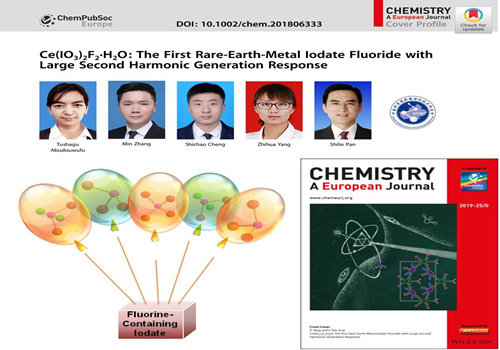ABOUT US
RESEARCH
SCIENTISTS
INT'L COOPERATION
EDUCATION
Progress in Design and Synthesis of Nonlinear Optical Crystal Materials of Fluorine Containing Iodate
Editor: | Jan 18,2019
With the development of all-solid-state laser technology in the fields of optical communication, optical processing and optical storage, deep ultraviolet and infrared nonlinear optical crystal materials have become a research hotspot. Therein, metal iodate crystals play an important role in the field of nonlinear optical crystals due to their strong frequency multiplication effect, wide transmission range (from visible to far-infrared range), high thermal stability and optical damage threshold. The requirement of designing nonlinear optical materials is how to construct the formation of non-centrosymmetric structure and how to increase the polarizability of the materials. Recently, Shilie Pan research group at Xinjiang Technical Institute of Physics & Chemistry, Chinese Academy of Science, has successfully synthesized a series of novel fluorooxoborates and fluorooxophosphates, etc. nonlinear optical crystal materials (J. Am. Chem. Soc., 2017, 139, 10645; Angew. Chem. Int. Ed., 2017, 56, 14119; Nat. Commun., 2018, 9, 3089; Angew. Chem. Int. Ed., 2018, 57, 9828.), which provide a way to design, synthesize and prepare new materials.
In recent years, the research team has also obtained a series of excellent nonlinear optical crystal materials based on iodate system. Since the electronegativity of fluorine is stronger than that of oxygen, the introduction of the F atoms into the bismuth iodate systems can not only regulate the overall structure but also broaden the band gap and generate high laser damage threshold (LDT). After a lot of attempts, a new metal oxyiodate fluoride, Bi3OF3(IO3)4, was successfully synthesized for the first time. The crystal exhibits excellent properties, which shows large SHG efficiency (6 × KDP) and high LDT (10 × AgGaS2). Notably, the introductions of fluorine into bismuth iodate systems generate a carbon-nanotube-like topological structure combined with wide transmittance range (0.3?12 μm). The results provide a feasible way to design new NLO materials and explore the growth of large-sized crystals. The study was published in Chemistry of Materials (Chem. Mater. 2017, 29, 945).
Later, our group searched the Cs-I-O-F system and designed and synthesized a series of fluorine containing iodate crystals with excellent performance. CsIO3 was selected as a maternal structure and three new derivatives, namely, CsIO2F2, Cs3(IO2F2)3·H2O, and Cs(IO2F2)2·H5O2, were successfully prepared by introducing different units (F?, H2O, H5O2+, and IO2F2?) under hydrothermal condition for the first time. Then, the structural transformations were schematically analyzed and the corresponding properties originated from ions introduction were investigated. Therein, non-centrosymmetric CsIO3 and CsIO2F2 exhibit good nonlinear optical properties with large second-harmonic generation (SHG) effects (15 × and 3 × KDP), wide band gaps (4.2 and 4.5 eV), wide transmittance ranges (~0.27?5.5 μm), and high laser damage thresholds (15 × and 20 × AgGaS2, respectively), which shows that they are potential nonlinear optical materials in near-ultraviolet to mid-infrared region. Attractive results show that a new structural strategy is proposed to design new functional materials, and large-scale crystals are also studied. The study was published in Chemistry of Materials (Chem. Mater. 2018, 30, 1136.).
Very recently, through further investigations on design and synthesis, our team successfully synthesized rare earth iodate fluoride, Ce(IO3)2F2·H2O, by introducing fluorine into rare earth iodate compounds for the first time. Rare earth iodates have very complex structural chemistry, especially attract the attention of researchers in nonlinear optics and luminescent materials. So far, there are no related reports on fluorine-containing rare earth iodate compounds found. In the structure, the CeO5F4 polyhedra connect with isolated IO3 groups to form one- dimensional infinite 1∞[Ce(IO3)2F2] chains, which interconnect with each other by weak hydrogen bond to construct the whole structure. Ce(IO3)2F2·H2O produces a large second harmonic generation response, which is 3 times that of KDP. Additionally, thermal studies and second harmonic generation properties were determined. The study was published on the Chemistry - A European Journal with title of “Ce(IO3)2F2·H2O: The First Rare Earth Iodate Fluoride with Large Second Harmonic Generation Response” as front cover.
In conclusion, the above results enrich the iodate chemistry, increase the diversity of crystal structure and expand the application prospect of fluorine-containing iodate in the field of nonlinear optics.
Paper 1:https://pubs.acs.org/doi/abs/10.1021/acs.chemmater.6b05468
Paper 2:https://pubs.acs.org/doi/abs/10.1021/acs.chemmater.7b05252
Paper 3:https://onlinelibrary.wiley.com/doi/abs/10.1002/chem.201804995

Functional units in fluorine-containing iodate and picture of front cover
附件下载:
 (86) 991-3838931
(86) 991-3838931 lhskj@ms.xjb.ac.cn
lhskj@ms.xjb.ac.cn (86)991-3838957
(86)991-3838957 40-1 Beijing Road
Urumqi, XinjiangChina
40-1 Beijing Road
Urumqi, XinjiangChina
